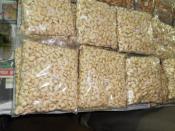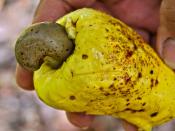The Cajueiro, also known as a cashew or Anacardium occidentale, is native to Brazil and certain areas of South and Central America. It usually grows in tropical forests and occasionally grassy areas. The tree grows up to 15 meters high (about 60 ft) and has a thick trunk with branches that encase and wind around the tree and that often reach the ground. On the lower branches, pink and yellow flowers grow on spikes and the fruit of the tree is a red or yellow pear-shaped object with a cashew nut that hangs below it.
Almost every part of the tree is harvested and used. The cashew nut is sold as food and the bark and leaves are often used medicinally. The shell around the nut is used for plastics and resin and the gum is also used medicinally or often for shampoos and lotion products. In some countries, the leaves are used for toothaches, oral problems, diarrhea and even to cure malaria; the bark is used to treat diabetes, cure fevers, as a laxative, and also to treat some oral infections; the gummy residue is applied to leprosy and fungal conditions; and finally the shell and shell oils are used to treat ringworm, leprosy, warts, psoriasis, and ulcers.
While the cajueiro has many other uses, those are the main purposes.
The nut or cashew part of the fruit, is very hard to extract from its outer shell. It must first be roasted until the sap made of anacardic acid squirts out of the layered shell and finally the acid, shell, and skin are removed before marketing. This process must take place before marketing because the oil around the nut is highly toxic (the whole tree is related to the poison sumac) and has been found to cause...


